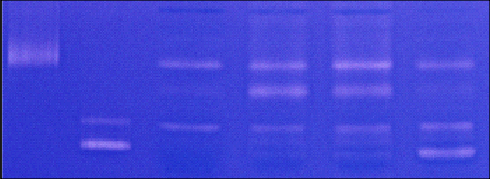
Navigation
Wound Healing Models
Physical Testing
Protease Regulation / Modulation
Anti-Microbial Efficacy Testing
Haemostat Assessment
Bio-compatibilty / degradation
Pre-clinical Research - Protease Regulation / Modulation
Testing of protease regulation by dressings
Method
|
•
|
Standard MMP solutions are prepared (MMP-
|
|
•
|
Standard sized samples of dressing are placed in a fixed volume of MMP solution (with a known and relevant level of protease activity)
|
|
•
|
The dressings samples are incubated in the protease solutions under controlled conditions
|
|
•
|
After incubation, the dressings are removed and the protease solutions tested for protease activity by Gelatin Zymography
|
|
•
|
The protease activity of MMP solutions exposed to the test dressing is compared to that of fresh (non-
|
|
•
|
The level of Protease Regulation is measured in terms of the level of reduction in MMP-
|
|
•
|
Less bleaching = more protease regulation
|
KEY POINTS
- Excessive activity of proteases is thought to be central to the development and persistence of chronic wounds.
- Proteases damage:
i) signalling molecules (growth factors).
ii) the protease shield – that protects tissues from damage.
iii) newly formed wound tissue.
- Various proteases are found in wounds including Matrix Metallo-
Proteases (MMPs) which are known to play a central role in wound chronicity.
- Supporting evidence for claiming protease regulatory status of products
- Dressings that can regulate protease activity may encourage chronic wound healing

IS YOUR DRESSING A PROTEASE REGULATOR?

Wound fluid Samples
|
•
|
Gelatin Zymography is the preferred technique for the measurement of protease activity by all leading academic laboratories.
|
|
•
|
Different proteases have different sizes (molecular weights).
|
|
•
|
Gel electrophoresis is used to separate proteases within a sample based on their molecular weight.
|
|
•
|
Gelatin is incorporated within the electrophoresis gels.
|
|
•
|
Once the proteases are separated by electrophoresis they are activated by the addition of calcium ions.
|
|
•
|
Activation causes the separated proteases to digest the gelatin in the electrophoresis gel.
|
|
•
|
When gels are stained for gelatin, areas where proteases have digested gelatin are translucent (see image above).
|
|
•
|
The level of protease activity is then determined by measurement of the level of colour loss.
|
|
•
|
More colour loss = more protease activity
|
Testing of wound proteases
|
•
|
Investigation of ‘Protease Regulation’ by dressings
|
|
•
|
Inactivation/Adsorption of MMPs by dressings
|
|
•
|
Ion depletion by dressings
|
|
•
|
Measurement of proteases in clinical trial wound fluid samples
|
|
•
|
Measurement of proteases in tissue/fluid samples from in vivo studies
|

Control dressing
Protease regulating dressing
Replicates
1
2
3
4
5
7
9
10
6
8
Replicates
1
2
3
4
5
7
9
10
6
8
MMP-9